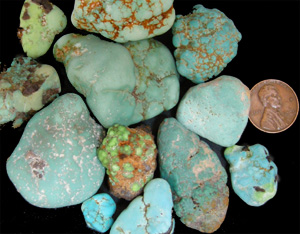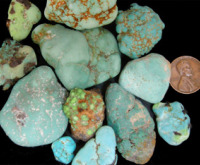Introduction & History of Turquoise

 Carico Lake Mixed Green
Carico Lake Mixed GreenFor thousands of years the finest and most intense blue turquoise in the world was found in Persia, and the term "Persian Turquoise" became synonymous with the finest quality and most valuable turquoise. The ancients preferred blue because a gem-grade blue stone would not change color (King Tut's treasures include a substantial amount of this type of blue turquoise and the colour appears unchanged today.The mines of Nishapur, in northeastern Iran, described in 1300 AD as having belonged to Isaac, the son of Abraham, supplied turquoise to Europe and Western Asia for centuries.
This changed during the late 1800's and early 1900's when modern miners discovered or rediscovered significant deposits of high-quality turquoise in the western and southwestern United States. Material from many of these deposits was just as fine as the finest from Persia Today, the term "Persian Turquoise" is more often a definition of quality, rather than a statement of origin.
Exactly when turquoise first came to the attention of man is unknown. We have archeological as well as literary references that pre date the Christian era by five millennia. The four bracelets of Queen Zar, found on her mummified arm, date to the second ruler of the Egypt's First Dynasty, approximately 5500 BC. Turquoise was used for beads by the Egyptians. Combined with other ornamental stones, the turquoise was inlaid in gold by Sumerians and Egyptians to produce very sophisticated articles of Jewelry.
Large mines were reported around 3,200 BC in the Sinai. The oldest known source of turquoise is the Maghara Wadi mines in the Sinai Peninsula. Mining expeditions of up to several thousand laborers were sent there annually. These mines were worked for the pharaohs for 2000 years. They were rediscovered in the mid-nineteenth century and worked on and off until the beginning of this century.
Turquoise was worn by Pharaohs and Aztec Kings. Its prized blue color is so distinctive that its name is used to describe any color that resembles it. Pre-Columbian Indians in Mexico, as well the American Southwest, used turquoise for beads and pendants.
The Anasazi and Hohokam mined turquoise throughout our Southwest. Absolute evidence exists that these prehistoric people mined turquoise at both Cerillos and in the Burro Mountains of New Mexico; also, at Kingman and Morenci in Arizona as well as the Conejos areas of Colorado. Turquoise was a popular trade item. We know this because so much has been found in archeological sites, many hundreds of miles away from its source. A prime example is the Cerillos, New Mexico, turquoise found in the Aztec regions of central Mexico.
